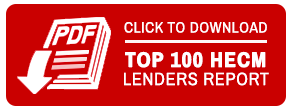 ⬇︎WATCH THE VIDEO SUMMARY BELOW ⬇︎
⬇︎WATCH THE VIDEO SUMMARY BELOW ⬇︎Download this month’s report [pdf]
View Annual Historical HECM Endorsements

What are the latest ranking changes in the Top-10-Lenders? Here’s the percentage of total endorsements that come from the top twenty retail HECM lenders.
August Endorsement Commentary
by James E. Veale, CPA, MBAHUD has released the HECM Endorsement Summary Report for August 2024, which shows 2,200 endorsements—slightly below the monthly average of 2,215 for this fiscal year. The total endorsements for the fiscal year to date (11 months) stand at 24,368. Unfortunately, these figures, the CNAs (Case Number Assignments) from May (or even June) 2024, and a (overestimated) pull-through rate of 70%, further ensure that the endorsement total for the fiscal year ending September 30, 2024, will result in the total annual endorsements for fiscal year 2024 ending up as the worst such total since fiscal year 2003.
To match the current lowest annual endorsement count from fiscal year 2019, September 2024 must see at least 6,906 endorsements. Some optimists may believe this is achievable; however, no single month of endorsements has exceeded 6,905 since March 2011.
What happened to the days when fiscal years produced annual endorsements of over 100,000? The issue isn’t demand—many eligible seniors aged 62 and older want HECMs but often find themselves “short to close.” The real problem lies on the supply side: current PLFs (Principal Limit Factors) are not as generous as they were in 2007-2009, the fiscal years when annual endorsements exceeded 100,000.
In our industry, when supply is an issue, it usually means lenders are offering low PLs (Principal Limits). Yet why would lenders raise PLs if HUD isn’t willing to insure such HECMs? HUD claims it cannot provide the necessary data which might justify higher PLFs, as it does not currently produce a report reflecting such information. Given that the data only dates back to October 1, 2008, HUD should be able to produce this report—albeit at a cost. At the end of fiscal year 2013, the US Treasury made a mandatory appropriation of $1.7 billion, a portion of which could be used for this purpose, even if it requires creating new accounting records to accommodate such reporting. Accessing the necessary funds may require congressional approval, but the resources are available.
For those who doubt the current Administration will allow such funds to be allocated for accounting purposes, remember that a new Administration will be inaugurated in less than five months. Vice President Kamala Devi Harris, if elected, could bring a different HUD agenda than President Joseph Robinette Biden. Similarly, if Donald John Trump is re-elected, he will most likely have his own distinct approach as well. Currently, the country has an Acting Secretary of HUD, and while Ms. Gordon may return as FHA Commissioner after January 19, 2025, we are likely to see a new Secretary of HUD shortly after the Presidential Inauguration.
As noted, fiscal year 2025 which has not started is already beginning poorly. The first quarter may yield the lowest total HECM endorsements for any first fiscal quarter since fiscal year 2002 (yes worse than 2003)—hardly the optimistic outcome the industry anticipates.
This NRMLA Convention is crucial, not just in terms of subject matter but also timing. Rather than passively embracing optimism, it’s essential to advocate for increased PLFs, while HUD is in the same room. HUD is not the adversary, but they need to understand the industry’s necessity for higher PLFs if we hope to see PLF increases implemented by October 1, 2025.
If you’re indifferent to next fiscal year’s outcome, enjoy the convention without concerns. However, if you seek change, ensure your voice is heard—respectfully, politely, but firmly. While we may not know August 2024’s total CNA count before the NRMLA Convention begins, the current facts do not inspire optimism for fiscal year 2025.
As for fiscal year 2024, it’s best to write it off; it is dismal for HECM endorsements. Three of the last six fiscal years, including 2024, rank among the worst since 2003. Fiscal year 2024 is expected to be the worst, pushing fiscal year 2019 to second worst and fiscal year 2023 to third worst. If someone had predicted this outcome back in summer 2017, I would have laughed.
It’s premature to dismiss fiscal 2025 since it hasn’t started. By analyzing trends, I hope to estimate HECM endorsement production by the end of the first calendar quarter of 2025.
If no action is taken and we rely on the market to resolve the supply-side issues, the outlook for endorsements will be bleak—unless interest rates drop sufficiently to revive HECM (i.e., HECM-to-HECM) Refi endorsements. With two months already looking doubtful, only ten months remain in fiscal 2025 to achieve a strong endorsement year. Without a significant increase in PLFs, it seems that only a substantial surge in HECM Refis can reverse the trend. HUD has predicted that the net present value of future cash flows from HECMs endorsed in fiscal year 2022 will result in a loss of over $800 million to the MMIF (Mutual Mortgage Insurance Fund). If the HUD projected outcome for fiscal year 2025 mirrors this, expect HUD to react by reducing PLFs further no later than October 1, 2026.







No comment yet, add your voice below!